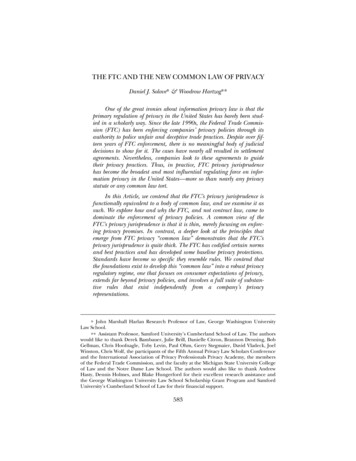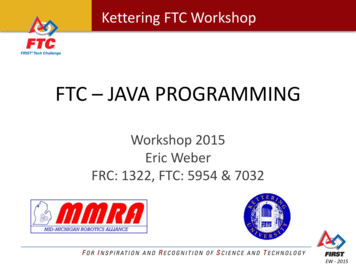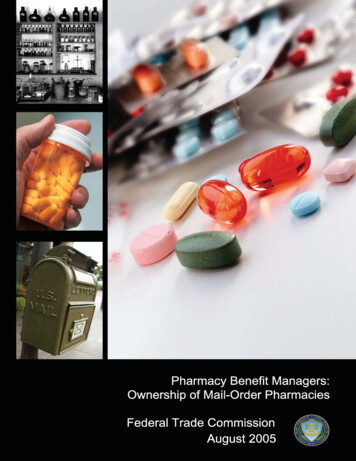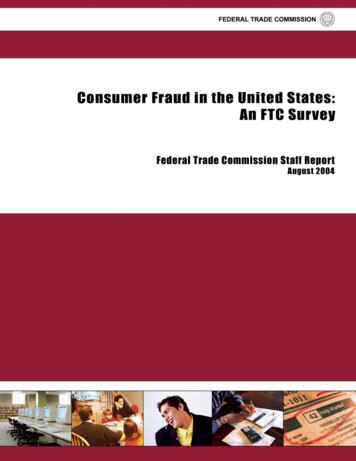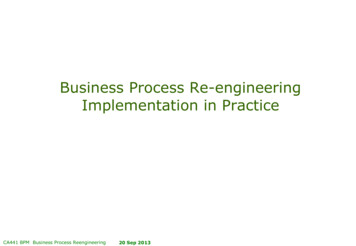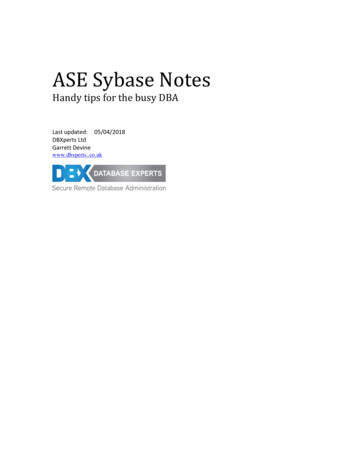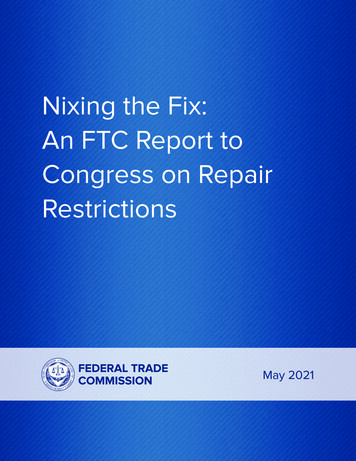
Transcription
Nixing the Fix:An FTC Report toCongress on RepairRestrictionsMay 2021
Table of ContentsEXECUTIVE SUMMARY . 3I.THE ANTI-TYING PROVISION OF THE MAGNUSON MOSS WARRANTY ACT 7II. COMPETITION ISSUES RELATING TO REPAIR MARKETS . 9A.Antitrust Principles Related to Manufacturer Restrictions on Repair . 11C.Monopolization Claims Involving Aftermarket Restrictions . 14III. INFORMATION GATHERING PROCESS . 16IV. TYPES OF REPAIR RESTRICTIONS. 17A.Physical Restrictions . 18B.Unavailability of Parts, Manuals, and Diagnostic Software/Tools . 181.Unavailability of Parts. 182.Unavailability of Manuals . 193.Unavailability of Diagnostic Software and Tools. 19C.Designs that Make Independent Repairs Less Safe . 19D.Steering Consumers to Manufacturers’ Repair Networks Using TelematicsSystems . 21E.Application of Patent Rights and Enforcement of Trademarks . 22F.Disparagement of Non-OEM parts and Independent Repair Services . 22G.Software Locks, Digital Rights Management, and Technological ProtectionMeasures . 23H.V.End User License Agreements . 24MANUFACTURERS’ EXPLANATIONS FOR REPAIR RESTRICTIONS . 24A.Protection of Intellectual Property . 24B.Safety . 26C.Cybersecurity. 30D.Liability and Reputational Harm . 32E.Design Choices and Consumer Demand Drive the Repairability of the Devices . 33F.Quality of Service . 36VI. RIGHT TO REPAIR ADVOCATES’ ARGUMENTS AGAINST REPAIRRESTRICTIONS . 38A.Timing of Repairs . 39B.Price of Repairs . 40C.Environmental Harm . 41D.Small Businesses and Employment. 421
VII. APPROACHES FOR INCREASING CONSUMER CHOICE IN REPAIRMARKETS . 44A.FTC Rulemaking or Law Enforcement . 44B.Industry Self-Regulation. 45C.Legislative Approaches . 47D.1.Existing State Right to Repair Laws and Model Legislation. 472.The European Approach . 48Transparency of Repairability by OEMs/Industry. 50VIII.IDENTIFICATION OF ISSUES TO BE CONSIDERED IN ANY ACTIONTAKEN BY INDUSTRY, POLICYMAKERS, OR LEGISLATORS . 50A.Types of Products Covered. 51B.Components of Covered Products . 52C.Dollar Threshold and the Duration of Repair Commitments . 52D.Protection of IP rights . 53IX. CONCLUSION . 542
EXECUTIVE SUMMARYThe Federal Trade Commission (“FTC” or “Commission”) submits this report pursuantto Congress’s directive for the Commission to report to the Committees on Appropriations of theHouse and Senate regarding anticompetitive practices related to repair markets. 1 When directingthe Commission to issue this report, Congress noted that it “is aware of the FTC’s ongoingreview of how manufacturers—in particular mobile phone and car manufacturers—may limitrepairs by consumers and repair shops, and how those limitations may increase costs, limitchoice, and impact consumers’ rights under the Magnuson-Moss Warranty Act.” Congressspecifically directed the FTC to include recommendations on how to best address theseproblems. 2To fulfill this Congressional directive, the Commission has synthesized the knowledgegained from its July 16, 2019 workshop titled “Nixing the Fix: A Workshop on RepairRestrictions” (the “Workshop”), public comments, responses to a Request for EmpiricalResearch and Data, 3 and independent research. This report examines consumer protection andantitrust issues relating to repair restrictions, with particular emphasis on those imposed bymobile phone and car manufacturers.Congressional interest in the competition and consumer protection aspects of repairrestrictions is timely. Many consumer products have become harder to fix and maintain.Repairs today often require specialized tools, difficult-to-obtain parts, and access to proprietarydiagnostic software. Consumers whose products break then have limited choices.Furthermore, the burden of repair restrictions may fall more heavily on communities ofcolor and lower-income communities. 4 Many Black-owned small businesses are in the repairand maintenance industries, 5 and difficulties facing small businesses can disproportionatelyaffect small businesses owned by people of color. 6 This fact has not been lost on supporters ofHouse Report 116-456 published in the Congressional Record on Dec. 27, 2020 116hrpt456.pdf) that accompanied H.R. 7668, Financial Servicesand General Government Appropriations Bill, 2021.2Id.3The full docket of public comments and empirical research submissions is available /document and 0001/comment. Citations in this report to the public comments or empirical research submitted inconnection with the Workshop provide the submitter’s name and whether the document was submitted as acomment or empirical research.4Commissioners Phillips and Wilson note that the claim suggested in this paragraph, i.e., that the burden of repairrestrictions at issue in this Report will fall more heavily on minority communities, is not supported by the evidencecited. That may very well be the case, as the Report’s caveats with words like “may” and “can” denote. But theclaim is a conclusion drawn by authors of the Report from citations to evidence of other things.5See, e.g., Interesting Facts & Statistics About Black-Owned Businesses, ack-owned-businesses.html (last visited Mar. 19, 2021) (stating that nearly 38 percent of Black-ownedbusinesses are in health care, social assistance, repair and maintenance, and personal and laundry services).6The pandemic offers a troubling example: “Nationally representative data on small businesses indicate that thenumber of active business owners fell by 22 percent from February to April 2020 — the largest drop on record.While the overall decline is noteworthy, differences among closure rates across racial and ethnic groups are evenmore striking. Black businesses experienced the most acute decline, with a 41 percent drop. Latinx business owners13
prior right to repair legislation, who have highlighted the impact repair restrictions have on repairshops that are independent and owned by entrepreneurs from underserved communities. 7 Repairrestrictions for some products—such as smartphones—also may place a greater financial burdenon communities of color and lower-income Americans. 8 According to Pew Research, Black andHispanic Americans are about twice as likely as white Americans to have smartphones, but nobroadband access at home. 9 Similarly, lower-income Americans are more likely to besmartphone-dependent. 10 This smartphone dependency makes repair restrictions on smartphonesmore likely to affect these communities adversely.The pandemic has exacerbated the effects of repair restrictions on consumers. As notedby Pew Research, “The pandemic has made living without a computer harder than ever.Employees are working remotely, kids are going to school via laptop, and grandparents arevisiting with their grandkids on screens. At the same time, the pandemic has made it harder toget broken devices fixed, as many big chain stores have ceased offering on-site repairs. As aresult, people have been forced to send their devices to authorized repair facilities—often waitingweeks for them to be returned.” 11The pandemic also has revealed a drastic shortage in the availability of new laptops forstudents. An Associated Press examination of the availability of school laptops found that thefell by 32 percent and Asian business owners dropped by 26 percent. In contrast, the number of white businessowners fell by 17 percent.” Claire Kramer Mills, Ph.D., and Jessica Battisto, Double Jeopardy: COVID-19’sConcentrated Health and Wealth Effects in Black Communities, Federal Reserve Bank of New York (Aug. y/FedSmallBusiness/files/2020/DoubleJeopardy COVID19andBlackOwnedBusinesses; See also Lydia DePillis, How the Pandemic Economy Could Wipe Out a Generation of BlackOwned Businesses, Pro Publica (Mar. 4, 2021), xistential-threatto-black-owned-businesses (stating that “[a]s of 2012 — the most recent data the Census Bureau has collected —average annual sales for a Black-owned business came to about 58,000, compared to nearly 10 times that amountfor the average white-owned enterprise” and arguing that “years of compounding disadvantage have beenexacerbated by the pandemic”).7aftermarketNews Staff, Reps. Towns and Sanchez Call Say Right to Repair Needed to Save Independent, MinorityOwned Repair Shops, (Feb. 16, 2006), ndent-minority-owned-repair-shops-jobs/.8According to U.S. PIRG, “Repair could reduce household spending on electronics and appliances by 22 percent,which would save an average family approximately 330 per year.” Alex DeBellis and Nathan Proctor, RepairSaves Family Big, U.S. PIRG, 4 (Jan. RepairSavesFamiliesBig/Repair-Saves-FamiliesBig USP Jan2021 FINAL1a.pdf; see also infra note 237.9Mobile Fact Sheet, Pew Research Center, (June 12, 2019) ile/#who-is-smartphone-dependent.10According to Pew Research: “With fewer options for online access at their disposal, many lower-incomeAmericans are relying more on smartphones. As of early 2019, 26% of adults living in households earning less than 30,000 a year are ‘smartphone-dependent’ internet users—meaning they own a smartphone but do not havebroadband internet at home. This represents a substantial increase from 12% in 2013. In contrast, only 5% of thoseliving in households earning 100,000 or more fall into this category in 2019.” Monica Anderson and MadhumithaKumar, Digital divide persists even as lower-income American make gains in tech adoption, Pew Research Center,(May 7, 2019), ns-make-gains-in-tech-adoption/.11Elaine S. Povich, Pandemic Drives Phone, Computer ‘Right-to-Repair’ Bills, (Mar. 11, e-computer-right-torepair-bills.4
increased demand for computers and supply chain challenges posed by the pandemic hadresulted in laptop shortages in school districts around the country. 12 For instance, California hasreported the need for 1 million laptops for students and Alabama was waiting on 33,000 studentcomputers. 13 Kinks in the semiconductor supply chain are now posing an additional threat to thesupply of new laptops. 14 Reducing barriers to repair may permit older laptops to be refurbishedmore easily, thereby expanding the supply of available laptops.The Commission’s concern with repair restrictions 15 dates back more than forty years, towhen the Commission’s then-Chairman testified in favor of the anti-tying provision of theMagnuson-Moss Warranty Act (the “MMWA”). 16 The anti-tying provision, Section 102(c) ofthe MMWA, prohibits a warrantor of a consumer product from conditioning its warranty on theconsumer’s using any article or service which is identified by brand name unless the article orservice is provided for free or the warrantor obtains a waiver from the Commission. Thisprovision, for example, bars an automobile manufacturer from voiding a warranty if a consumerhas scheduled maintenance performed by someone other than the dealer, prohibits a printermanufacturer from conditioning its warranty on the purchaser’s use of the manufacturer’sbranded ink, and forbids a smartphone manufacturer from voiding a warranty when a consumerhas a new battery installed at a kiosk at the mall. In short, the anti-tying provision barsmanufacturers from using access to warranty coverage as a way of obstructing consumers’ability to have their consumer products maintained or repaired using third-party replacementparts and independent repair shops. 17 As discussed in Section I, below, the Commission hasactively enforced the anti-tying provision of MMWA and will continue to address illegalpractices in the marketplace.In the 44 years since the enactment of the MMWA, technological developments haveintroduced new challenges that warrant a reconsideration of whether the anti-tying provision hasJocelyn Gecker and Michael Liedtke, AP Exclusive: US Faces Back-To-School Laptop Shortage, (Aug. 22, adc35ddc8f4c946.13Mackenzie Hawkins, California is short 1 million laptops and hot spots for kids as it prepares online school,Sacamento Bee, (July 22, 2020) pitolalert/article244418057.html.14Hyunjoo Jin, Douglas Busvine, and David Kirton, Analysis: Global chip shortage threatens production of laptops,smartphones and more, Reuters, (Dec. 17, 2020), 0ZL.15We use the term “repair restriction” to refer to any practice that has the effect of limiting consumers’ ability torepair products that they own. In using this term, we focus on the impact of practices that limit consumer choiceregarding repairs rather than on the intent of manufacturers. Due to this focus, the report does not delve into thesubject of “planned obsolescence”—the argument that manufacturers intentionally design products to fail in order toencourage future replacement purchases.16Then-Chairman Lewis Engman testified:This provision addresses the anticompetitive practice which the Commission has opposed innumerous court actions wherein a manufacturer uses a warranty unreasonably to tie hissupplementary products or services to the warranted product. This leaves the consumer in theundesirable posture of losing his warranty protection if he purchases the supplementary items fromanother and perhaps less expensive source—even if he does so in complete ignorance of thewarranty’s provisions.Statement of Hon. Lewis A. Engman, Chairman, Federal Trade Commission, included in H. Rep. No. 93-17, at 58(1973).17Independent repair shops are also referred to as independent service organizations (“ISOs”).125
kept pace with the evolving consumer goods repair market. Even when a warranty does notexplicitly require that repairs be performed by the original equipment manufacturer (OEM) usingOEM parts, many manufacturers restrict independent repair and repair by consumers through: Product designs that complicate or prevent repair;Unavailability of parts and repair information;Designs that make independent repairs less safe;Policies or statements that steer consumers to manufacturer repair networks;Application of patent rights and enforcement of trademarks;Disparagement of non-OEM parts and independent repair;Software locks and firmware updates; orEnd User License Agreements.Manufacturers explain that these repair restrictions often arise from their desire to protectintellectual property rights and prevent injuries and other negative consequences resulting fromimproper repairs.The report is divided into nine sections. The first describes Section 102(c) of theMMWA and the Commission’s record of enforcing this provision. Section Two provides ananalysis of the competition issues related to repair markets. Section Three describes staff’sinformation gathering efforts, including a description of the Workshop and comments. SectionFour catalogues the types of repair restrictions employed by manufacturers. Section Fivedescribes the explanations manufacturers offer for repair restrictions. Section Six examines thearguments of repair advocates.The final sections of this report propose ways to expand consumers’ repair andmaintenance options. Section Seven describes several approaches that could increaseconsumers’ choice in repair markets. Section Eight focuses on challenging issues that wouldneed to be considered by industry, regulators, and legislators that attempt to expand consumers’repair choices.Finally, in Section Nine, we conclude by explaining that, based on the record before us, itis clear that repair restrictions have diluted the effectiveness of Section 102(c) and steeredconsumers into manufacturers’ repair networks or to replace products before the end of theiruseful lives. Based on a review of comments submitted and materials presented during theWorkshop, there is scant evidence to support manufacturers’ justifications for repairrestrictions. 18 Moreover, the specific changes that repair advocates seek to address manufacturerrepair restrictions (e.g., access to information, manuals, spare parts, and tools) are well supportedby comments submitted for the record and testimony provided at the Workshop. While the carmanufacturing industry has taken important steps to expand consumer choice, other industriesthat impose restrictions on repairs have not followed suit. The Commission will considerreinvigorated regulatory and law enforcement options, as well as consumer education. Inaddition to the FTC’s pursuit of efforts under its authority, the Commission stands ready to workCommissioner Wilson and Commissioner Phillips note that the report excludes from the scope of its coverage ananalysis of manufacturers’ intellectual property rights, which may provide legitimate justification for some repairrestrictions.186
with legislators, either at the state or federal level, to ensure that consumers and independentrepair shops have appropriate access to replacement parts, instructions, and diagnostic software.I.THE ANTI-TYING PROVISION OF THE MAGNUSON MOSS WARRANTYACTThe Federal Trade Commission enforces the MMWA, a consumer protection law passedin 1975 to clarify how written warranties may be used when marketing products to consumers. 19The MMWA requires warrantors of consumer products to provide consumers with detailedinformation about warranty coverage. 20 Section 102(c) of the MMWA prohibits warrantors fromconditioning warranty coverage on the consumer’s use of an article or service identified bybrand, trade, or corporate name, unless the warrantor provides that article or service withoutcharge or the warrantor has received a waiver from the Commission. 21 Companies may seek awaiver of this prohibition if: (1) the warrantor satisfies the Commission that the manufacturers’parts or services are necessary for the product to function, and (2) the waiver is in the publicinterest. 22 Since 1975, only three waiver requests have been made to the Commission, all ofwhich were denied. 23The FTC has issued three Rules under the MMWA, the Rule on Disclosure of WrittenConsumer Product Warranty Terms and Conditions (the Disclosure Rule), 16 C.F.R. pt. 701, theRule on Pre-Sale Availability of Written Warranty Terms (the Pre-Sale Availability Rule),16 C.F.R. pt. 702, and the Rule on Informal Dispute Settlement Procedures (the DisputeResolution Rule), 16 C.F.R. pt. 703. Unlike many of the FTC’s Rules, the FTC lacks theauthority to seek civil penalties when enforcing the three Rules it promulgated under theMMWA. Instead, the Commission can obtain an injunction. In addition, the FTC has issuedInterpretations of the MMWA—a document that clarifies certain terms and explains some of theprovisions of the MMWA. 24 In the Interpretations, the FTC provides guidance on Section 102(c)of the MMWA. As stated in the Interpretations, Section 102(c) applies not only to expressstatements, but also implied language that a warranty is conditioned on the use of particularproducts or services. For example, a provision in the warranty such as, “use only an authorized‘ABC’ dealer” or “use only ‘ABC’ replacement parts,” is prohibited where the service or partsare not provided free of charge pursuant to the warranty. 2515 U.S.C. § 2301 et seq.Id.2115 U.S.C. § 2302(c).22Id.23Denial of Waiver of Section 102(c) of the Magnuson-Moss Warranty Act, 41 Fed. Reg. 17821 (Apr. 28, 1976)(waiver requested by Sohmer & Co., Inc., a piano manufacturer); Denial of Waiver of Magnuson-Moss WarrantyAct, 41 Fed. Reg. 34368 (Aug. 13, 1976) (waiver requested by Harmsco, Inc., a manufacturer of swimming poolwater treatment systems); Denial of Waiver of Section 102(c) of the Magnuson-Moss Warranty Act, 43 Fed. Reg.1991 (Jan. 13, 1978) (waiver requested by Coleman Co., Inc., a manufacturer of heating and cooling appliances andassociated equipment for mobile homes).2416 C.F.R. pt. 700 (2015).25The Interpretations explain that Section 102(c) does not preclude a warrantor from expressly excluding liabilityfor defects or damage caused by articles or services not provided by the manufacturer. Nor does Section 102(c) barthe warrantor from denying liability where the warrantor can demonstrate that the defect or damage was caused byarticles or service not provided by the manufacturer. 16 C.F.R. § 700.10 (2015).19207
In recent years, the FTC has actively enforced Section 102(c) of the MMWA. Forexample, in October 2015, the FTC approved a complaint and settlement against BMW forviolating the anti-tying provision. 26 In its complaint, the FTC alleged that BMW violated theMMWA by conditioning the warranties it offered on its MINI cars on the use of MINI dealersand genuine MINI parts without providing such parts and services for free or seeking a waiverfrom the FTC. Subsequently, in April 2018, the FTC announced that staff issued severalwarning letters to companies marketing automobiles, cellular devices, and video gaming systemsin the United States. The letters warned the companies that telling consumers they need to usespecified parts or services to keep the warranties intact would violate the anti-tying provision.The letters also placed the companies on notice that violations of the MMWA may result in legalaction. 27 The recipients changed their practices in response to the warning letters. A consumereducation campaign accompanying the warning letters also promoted awareness aboutconsumers’ rights under the MMWA. 28The Commission continues to receive reports of companies not complying with theMMWA. In response to staff’s call for empirical research and comments related to theWorkshop, several organizations reported that warranty tying continues to be prevalent in themarketplace. For example, the Education Fund of U.S. PIRG, the federation of state PublicInterest Research Groups (PIRGs), submitted an October 2018 study analyzing warranties from50 companies. 29 U.S. PIRG concluded that 45 of the 50 companies had warranties that appearedto violate Section 102(c) of the MMWA. 30 Likewise, the Specialty Equipment MarketAssociation (SEMA) submitted a comment stating that it regularly receives complaints thatautomobile dealerships void automobile warranties if the dealership finds a specialty part (e.g.,custom wheels) had been installed on the automobile, regardless of whether the specialty partcaused the automobile to malfunction. 31 Other commenters submitted information claiming thatcertain warrantors either expressly or by implication continue to condition warranty coverage ofthe use of particular products or services. 32 The Commission takes these allegations seriouslyand will continue to address illegal practices in the marketplace.In re BMW of N. Am., LLC, FTC No. 132-3150, 1323150/bmw-north-america-llc-matter.27FTC Warns Companies that It Is Illegal to Condition Warranty Coverage on the Use of Specified Parts orServices (Apr. 10, 2018), -warranty-coverage. Some of the warning letters also advised companies to stop placing seals ontheir products that stated “warranty void if seal removed,” or contained similar language.28See g/2018/04/ftc-staff-sends-warranty-warnings. Notably,however, the Automotive Oil Change Association submitted evidence showing that many consumers are stillunaware of their rights under the MMWA. Automotive Oil Change Association comment (“AOCA empiricalresearch”), at 12-14.29U.S. PIRG empirical research. See Nixing the Fix: A Workshop on Repair Restrictions, Docket ID FTC-20190013, https://www.regulations.gov/docket?D FTC-2019-0013. In this report, we refer to submissions as“comments” or “empirical research” based on how they were submitted to the Commission.30Id. at 2-3.31Special Equipment Market Association comment (“SEMA comment”), at 2. SEMA urged the Commission torequire dealerships to state in writing why the warranty coverage was denied.32E.g., Peter Pronko comment, at 1-2 (arguing that Rolex materials make statements such as, “only official Rolexrepair centers are ‘allowed’ to repair and service a Rolex watch” and that repair work done by anyone other than aRolex facility will void its warranty); Fixit Clinic empirical research, at 3 (describing “stickers or labels that warn or268
II.COMPETITION ISSUES RELATING TO REPAIR MARKETSThe FTC also enforces antitrust laws that, in some circumstances, could make repairrestrictions illegal. In antitrust parlance, repair restrictions concern aftermarkets—markets forparts or services that are used after the initial purchase of a product. Products with aftermarketsare very common. Examples range from simple products like razors and razor blades, tooperationally or technically complex products and services like software and software updates. 33The ways that businesses provide products and services in aftermarkets are similarly diverse, andlead to a range of participants and competitive dynamics in different markets.With respect to repairs, the relationships between market participants fall into three mainmodels. Some manufacturers offer repair services for their products themselves, or through anetwork of affiliates, as the only authorized means of repair. In other instances, an original equipment manufacturer (OEM) has no presence in thesale of aftermarket parts or service. In those cases, independent service organizations(ISOs) sometimes provide repair and maintenance services for the products of variousmanufacturers. In addition, consumers may be able to purchase replacement parts inan aftermarket, perhaps to perform repairs themselves. Some OEMs participate in aftermarket service markets in competition withindependent repair shops. Where that is the case, a manufacturer may steeraftermarket work toward its own services.Several scenarios described in this report involve business decisions made by themanufacturer that may restrict repair options by consumers or ISOs and make it difficult orimpossible for ISOs to compete in aftermarkets. Tying exists when the sale of one product (thetying product) is conditioned on the purchase of a second product (the tied product) from thesame firm. 34 Tying
The pandemic has exacerbated the effects of repair restrictions on consumers. As noted by Pew Research, “The pandemic has made living without a computer harder than ever. Employees are working remotely, kids are going to school via laptop, and g
